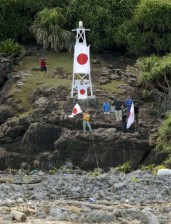Japan activists land, raise flags on disputed isle

Japanese activists wave the national flag in front of a lighthouse on Uotsuri island, one of the islands of Senkaku in Japanese and Diaoyu in Chinese, in East China Sea, Sunday, Aug. 19, 2012. A group of Japanese activists swam ashore and raised flags early Sunday on one of a group of islands at the center of an escalating territorial dispute with China. (AP Photo/Kyodo News)
SENKAKU ISLANDS, Japan – Japanese activists swam ashore and raised flags Sunday on an island claimed by both Japan and China, fanning an escalating territorial dispute between the two Asian powers.
Some 10 activists made an unauthorized landing on Uotsuri, the largest in a small archipelago known in Japan as the Senkaku Islands and in China as Diaoyu Islands. The uninhabited islands surrounded by rich fishing grounds are controlled by Japan but also claimed by China and Taiwan.
China’s Foreign Ministry protested Saturday, before the visit even happened.
“Any unilateral action taken by Japan on the islands is illegal and invalid,” it said in a statement issued on its website.
On Sunday, China’s official Xinhua News Agency reported that hundreds of people in cities across the country had marched in protest.
Article continues after this advertisementDays earlier, a group of 14 Hong Kong residents and mainland Chinese had traveled by boat to the islands, and some swam ashore. Japan arrested them on Wednesday for landing without authorization, and sought to quiet the regional spat by quickly deporting the group Friday. Plans for further visits by activists on both sides appear likely to further inflame the territorial tensions.
Article continues after this advertisementThe spat over long-contested territories comes as China’s ruling communist party prepares for a major leadership transition. Leaders on both sides face strong domestic pressure to defend national interests.
Frictions have also flared up recently over another set of disputed islands, controlled by South Korea.
South Korean President Lee Myung-bak visited the islands in the Sea of Japan, called Takeshima in Japanese and Dokdo in Korean, earlier this month. His visit was seen by many as an attempt to play up anti-Japan sentiment ahead of elections later this year.
The Coast Guard did not identify by name those who landed on Uotsuri Island on Sunday. They were members of a group of ultra-conservative parliamentarians and local politicians who were visiting waters off the disputed islands over the weekend to mourn for the victims of a boat accident near there at the end of World War II.
“Four days ago there was an illegal landing of Chinese people on the island — as such we need to solidly reaffirm our own territory,” said Koichi Mukoyama, a lawmaker who was among seven conservative parliamentarians aboard a boat in the flotilla of some 20 vessels that traveled to the islands.
Photos from Japan’s Kyodo News Agency showed several men and a woman, in street clothes still wet from swimming ashore, brandishing the Japanese flag atop rocks on the shore of the uninhabited island.
Last week’s visit by the Chinese activists raised calls by critics of Prime Minister Yoshihiko Noda’s government to take stronger action to protect the islands.
Protesters in Beijing, Hong Kong and other cities praised the activists as heroes and burned Japanese flags.
Japan says it has controlled the five main islands for more than 100 years. It has been trying to place four that are privately held under state ownership to bolster its territorial claim.